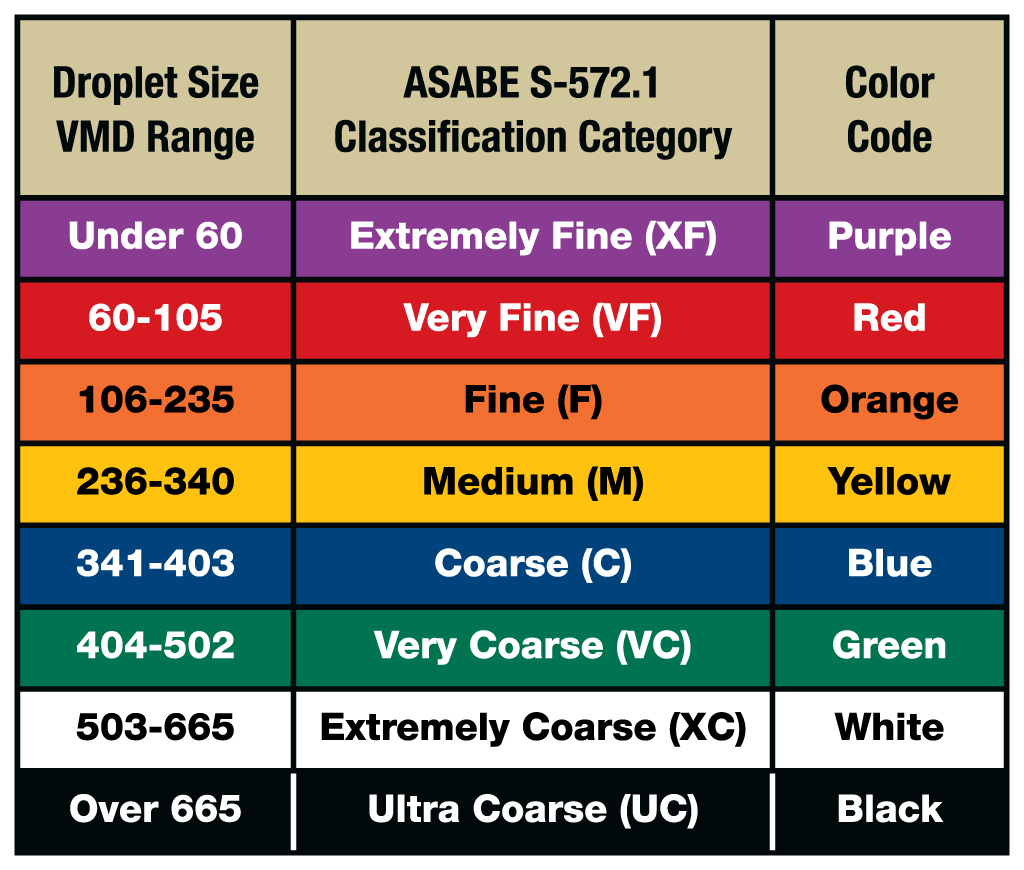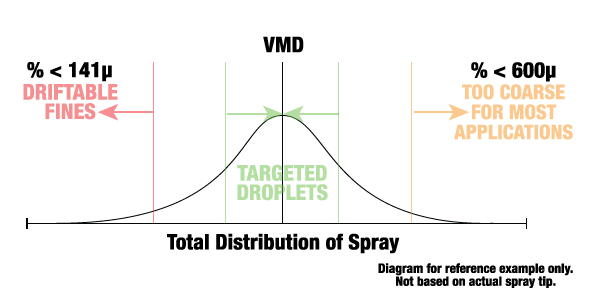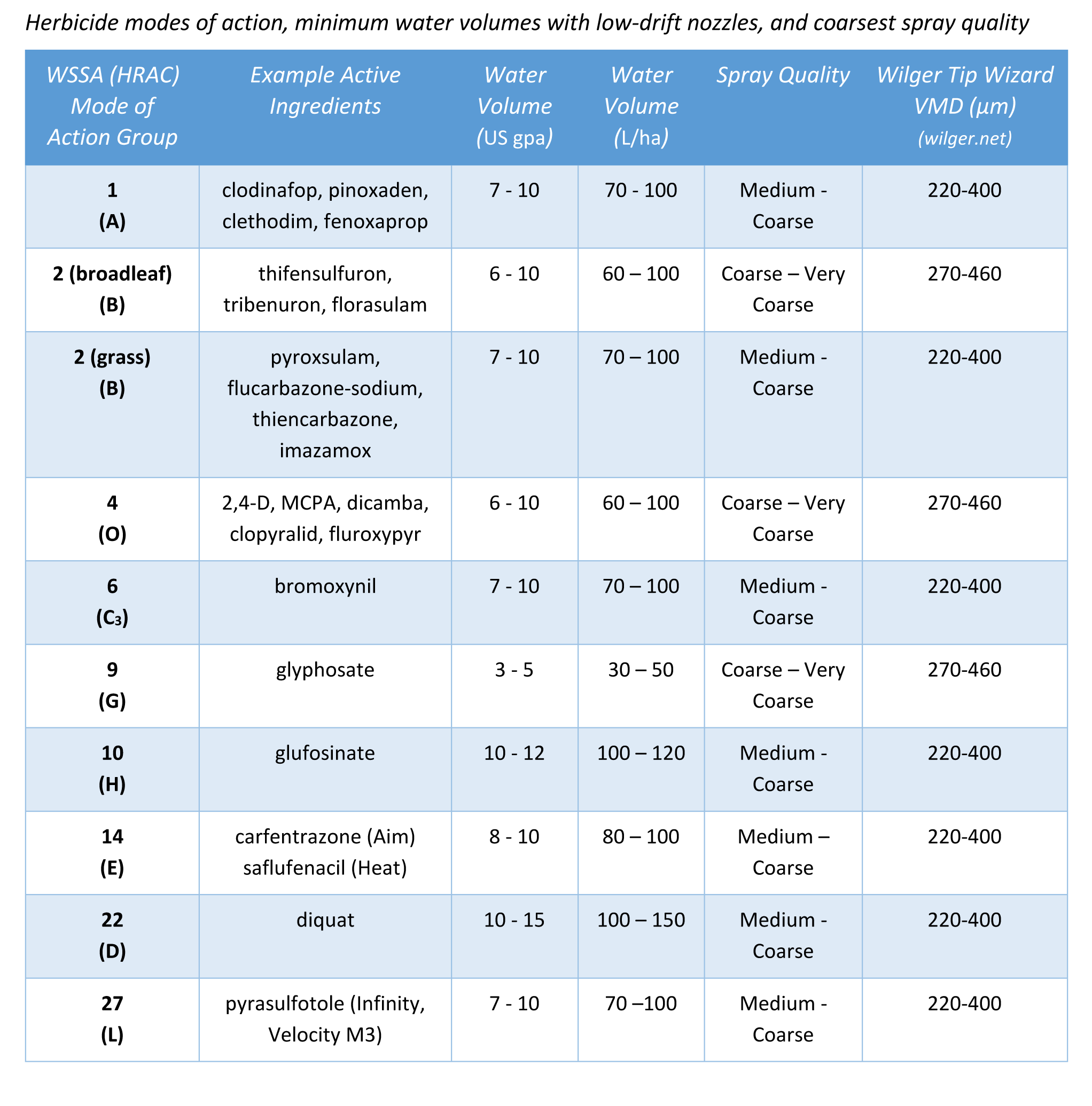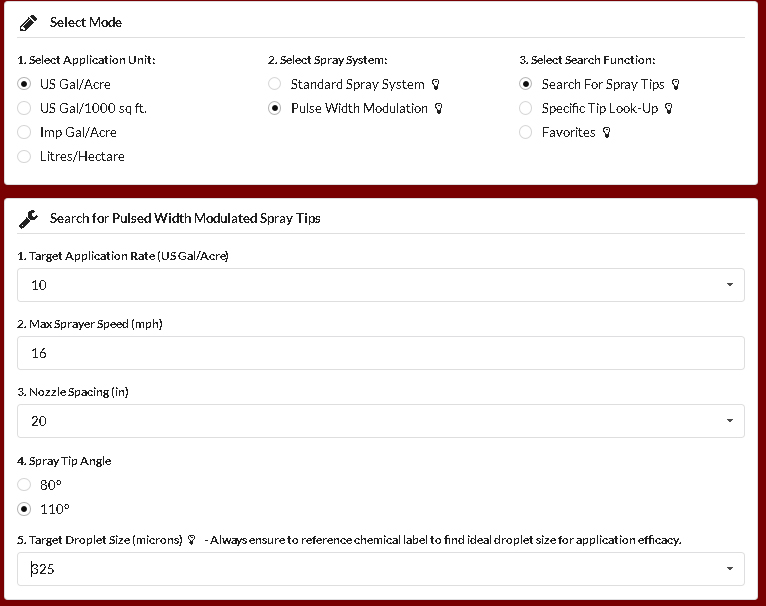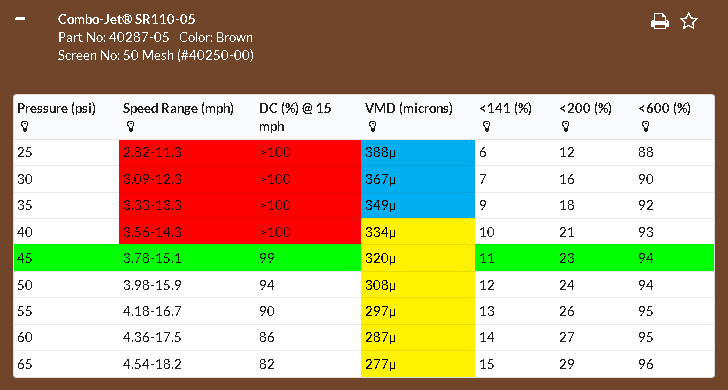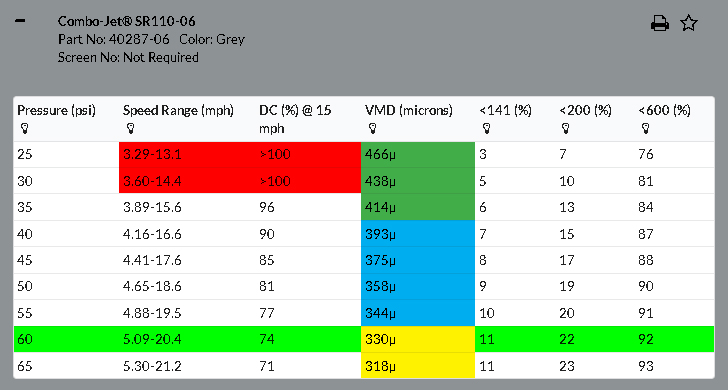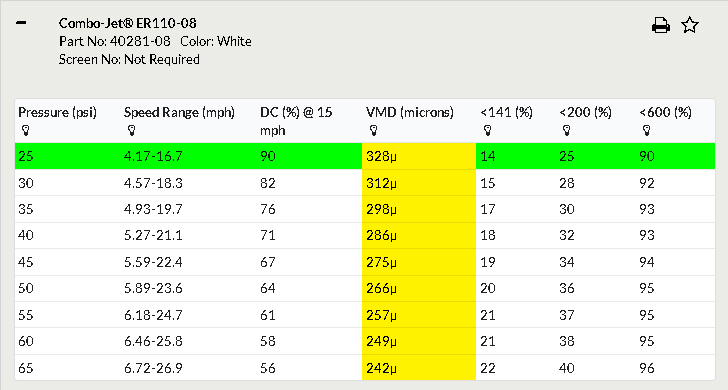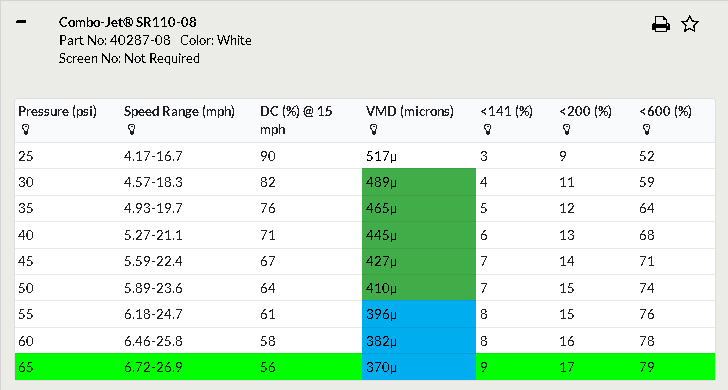Guide to Using Tip Wizardfor Pulse Width Modulation (PWM) Spray Systems

Now that you’ve found Tip Wizard, you might be overwhelmed by all of the information if provides you. Don’t worry, this guide will help.
As practice, this guide will go through a real life example tip selection, and will explain the information along the way. You are well on your way to gaining critical knowledge that will help your spray applications.
To properly size up and select a spray tip, some information is required from an operator [click on the below tabs for more information]:
Each chemical has its own required application rate, along with requirements for proper spray quality and other requirements. Note which units that your chemical label are referenced in. Common units include US Gallons/Acre, Litres/Hectare.
Quick Conversions:
Hectare x 2.471 = Acre
Acre x 43560 = Square Feet
Acre x 0.4047 = Hectare
Hectare x 10000 = Square Meter
160 Acres = 64.75 Hectares
With PWM sprayers, there are large speed ranges possible with spray tips, as the duty cycle will compensate for variation in flow rate required (along with the auto-rate controller).
The duty cycle is the effective ‘on time’ during a fixed pulse cycle. For example, a PWM system may pulse once, every 10th of a second. The frequency of pulses remains at that 10th of a second.
If the sprayer is spraying for half of that tenth of a second, it would have an effective duty cycle of 50%. A PWM sprayer’s capability to modulate flow rates and pressures across larger ranges comes from its ability to keep pressure consistent, and only modulate flow with the duty cycle.
Most PWM sprayer manufacturers recommend operating with duty cycles from 50-100%. If there was an ‘ideal’ duty cycle, it would likely be in the realm of 70-80%.
At a 70% duty cycle, you can effectively put out 30% more flow (or reduce flow similarly), without having to change the droplet size spectrum produced at your pressure.
This makes larger impact when PWM systems are equipped with turn compensation, as it allows for each individual nozzle act on its own to maintain the best fit for flow across a turning sprayer.
Duty cycle should be used as a pass/fail criteria in sizing up a spray tip. If a spray tip is within a reasonable travel speed and duty cycle, always put priority on spray tip selection on the spray quality/ drift reduction. Duty cycle can then be used as a secondary criteria.
Quick Conversions:
MPH x 1.6093 = km/h
km/h x 0.6214 = MPH
It is important to have a preferred operating pressure range, as it will help you isolate an ideal spray tip choice. Try to match a spray tip that applies your ideal droplet size close to your max (preferred) pressure, so your PWM system has the ability to drop your pressure for a ‘drift reduction mode’ at lower pressures.
Example:
If you are operating at 60PSI to achieve your ideal droplet size of 325 microns (medium spray quality), by ONLY changing the pressure in the PWM system (as the duty cycle will look after keeping the flow rate consistent), you’d be able to drop your pressure down to 40PSI and perhaps get a droplet size of 400 microns (coarse spray quality). This would result in reducing driftable fines significantly with your “drift reduction mode” set at 40PSI.
Some PWM system manufacturers recommend using 60PSI as a “maximum pressure”, advising that operating above the maximum is more than possible, but it can produce more seal wear.
Quick Conversions:
PSI x 14.5038 = BAR
To determine the flow rate required for an application, it is necessary to know your sprayers’ nozzle spacing. 20″ (or 50cm) is a fairly common standard, but there are many sprayers that have different nozzle/tip spacing.
Quick Conversion: Inch (IN) x 2.54 = Centimeter (CM)
The spray tip angle is required to ensure you are getting the correct spray pattern angle to ensure 100% overlap. Typical spray tip angle for self-propelled sprayers is 110°. Typical spray tip angle for pull-type sprayers, or sprayers with boom height exceeding 30″, will typically use 80° spray tips.
Having proper spray tip angle and mirroring it with proper boom height is paramount in maintaining consistent and even spray deposition.
Excessively low spray boom height can lead to poor spray distribution, as there is insufficient overlap of the spray pattern.
Excessively high spray boom height can lead to significant increases in driftable fines and less uniform spray coverage (due to further distance to travel).
Keeping a spray overlap at 100% gives a spray swath its best chance at maintaining an even spray distribution. Note: With some PWM systems, recommended boom heights do differ from conventional charts.
Since PWM systems have a huge capability in keeping the droplet size constant across different speeds, it is especially important to have a target droplet size in mind. This is based on the chemical and mode of action being used, and later in this guide, there are a few ways to determine the best droplet size for you.
Chemical Label requirements are effectively based on typical (or ideal) conditions for ideal efficacy. Unfortunately, most applicators do not get the opportunity to spray into ideal conditions. As such, there is the ability to comply with label and further tailor your spray quality to the actual conditions you experience on your farm.
For example, if the chemical label recommends a medium spray quality, that could be estimated to have a VMD in a range of 236-340 microns. So, now you have a rough idea of the spectrum you should be in to comply with the chemical label.
If your farm/fields are typically in moderate wind conditions, spraying with a medium droplet size on the low end of the ‘medium’ spectrum might provide poor results due to heavier driftable fines. Instead, it would be recommended to target a droplet size to the top end of the ‘medium’ spectrum, somewhere in the realm of 325-340 microns.
This would provide less driftable fines (compared to targeting a bare minimum ‘medium’), and allow better control of spray in your typical spraying conditions.
Not sure where to find what droplet size you should target?
Applying a chemical with a spray quality or droplet size that is tailored to the targeted application is critical and is the best practice for any spray application.
Spraying outside of the chemical label requirements or recommendations can lead to poor chemical efficacy and coverage, as well as excessive off-target drift. Each of those can result in avoidable consequences ranging from crop damage, environmental impact, as well as legal penalty.
Best Resource: Chemical Label & Information from Manufacturer
At every opportunity, first reference the chemical label to find the application recommendation (or requirements) as it relates to the physical droplet size to target with an application. This information may be shared in a few different ways including [but not limited to]: listing a VMD (volumetric median diameter) or Dv0.5 in microns, an ideal spray quality (e.g. ASABE COARSE droplet size), or even having a list of certified/allowed spray tips and their associated pressure ranges.
If you do not find a reference for an ideal droplet size in the chemical label, request the information from your chemical company representative, as they may have specific information about your intended application.
If possible, request a specific ideal droplet size to target in microns, as it will allow you to tailor your tip selection as close as possible to the very best application result.
Example Label Reference; this is a reference for a example ONLY, and should NOT be used as a general guide for any chemical:
Application Information:
- Water Volume:
- Ground: 20 to 40L per acre.
- Aerial: 12 to 20L per acre. Consult label for buffer zones.
- Nozzles and Pressure:
- Maximum 30 to 40 PSI (200 to 275 kPa) with conventional flat fan nozzles. Low drift nozzles may require higher pressures for proper performance. Use nozzles and pressure designed to deliver proper coverage with ASABE S572.1 coarse droplets.
The American Society of Agricultural and Biological Engineers developed a standard that isolates a classification of spray quality into a number of category ranges. These ranges (from Extremely fine to Ultra Coarse) reference the different spray qualities, based on their respective distribution of droplet size.
The full standard may be purchased from the ASABE here. Note the ASABE standard is effectively the testing protocol for Nozzle manufacturers and testing bodies to classify spray tips based on the steps and standards in ASABE S572.1. As testing machines and spray tips differ, results from different manufacturers can vary somewhat, in both their respective ASABE S572.1 ranges and as a result, their classifications.
Wilger tries to provide even further information with the ASABE standard. From testing tips at different pressures (with water at 70°F), Wilger provides a VMD (in microns) that shows the size of the median in a droplet spectrum of a tip at a certain pressure. This allows for at least a further step from spray quality classification to try narrow application to have peak efficacy.
For the ASABE classification, it does bring both VMD and Dv0.1 into account to qualify a certain classification of nozzle (at a certain pressure). This can lead to some confusion; for example, when two spray tip have a VMD of 380µ, but one is classified as COARSE, and one is EXTREMELY COARSE. Both are correctly classified, but the chance is that the one with a COARSE rating had a smaller/finer Dv0.1. that downgraded it’s rating to COARSE.
If you require any clarification on the ASABE standard S572.1 or how it is used to classify Wilger nozzles, please do not hesitate to contact us.
The Volumetric Median Diameter (VMD) or Dv0.5 is referenced as a middle point of a droplet distribution from a spray tip at a given pressure, so half of the volume would be made up of droplets smaller than the VMD, and half of the volume would be made up of droplets larger than the VMD.
If you rely on using the droplet size category only (e.g. COARSE), then you do not know if you are at the top, middle or bottom end of that droplet size category range. Whereas, using a micron size of 350 microns, you know you are applying on the lowest of the ‘coarse’ spectra.
For a cross-reference of what these category ranges and droplet size (in microns), see the ASABE S572.1 and VMD chart.
If the chemical label does not specify a droplet size or droplet category, it can be helpful to refer to general guidelines for the different types of chemicals as well as their respective modes of application and targets. ALWAYS check with chemical label thoroughly, as well as alternative resources direct from the chemical manufacturer prior to consulting guidelines.
For an example, find the below chart, differentiation a rough guideline of what kind of applications might warrant certain droplet sizes or categories.
NOTE: Wilger provides the above chart as an educational tool. ALWAYS ensure to get information specific to the chemical being applied from manufacturer, as information may differ from the chart above.
AGRONOMISTS
Professional agronomists can also provide supplementary information tailored to the best way to target and manage specific pests/weeds.
WEED EXTENSION STUDIES
Many Universities that have emphasis on agricultural studies often have weed extension programs that can be good resources when trying to improve an application to better target a specific weed/issue.
PROFESSIONAL AND EDUCATIONAL RESOURCES
As another guide to general modes of action for different herbicides, there are also reference charts, referring to each mode of action chemical group, as well as their intended targets.
One of such examples is shown by the team at Sprayers101.com, a useful website for reference information and education about improving spraying practices. Visit Sprayers101.com to see more information. [Website content developed by Dr. Jason Deveau and Dr. Tom Wolf]
For this example, we are applying a contact herbicide for in-crop control of grasses and broad leaf weeds (Using Glufosinate-ammonium; e.g. Liberty®)
Since we are targeting grassy and broadleaf weeds, we will want to ensure we have sufficient coverage to control the finer of the two targets (within environmental/drift sensitivity conditions). With a PWM system, as we can change the pressure at the tip on the go, we best spray at our ‘ideal pressure’ to get the best coverage that conditions will allow. From there, we will ensure there is room to drop our pressure (still on the go) to reduce drift for areas that require it.
As glufosinate-ammonium typically targets medium to coarser droplets, we will settle in the middle between medium and coarse. This is to allow for some wind conditions that are typically present, as Liberty is a drift sensitive herbicide. As for a VMD, this might be somewhere around 325µ. If conditions for another field have much greater drift sensitivity or environmental reasons to sacrifice coverage to minimize drift, the targeted VMD can be much greater. Alas, with larger droplets (and less drift), increasing water volumes is considered to improve coverage to offset the sacrifice of coverage.
Example Application Search
Required Chemical Application Rate: 10 US Gallons/Acre
Average Sprayer Travel Speed: 16 MPH (down to 9 MPH to turn corners)
Preferred Operating Pressure Range: 50 PSI (just to maintain exit velocity without pump having to maintain higher pressures)
Tip Spacing: 20″ nozzle/tip spacing
Spray Tip Angle: 110°
Target Droplet Size: Based on individual chemical application. For example (Glufosinate-ammonium – contact herbicide), lets use 325µ. [Since PWM sprayers have such a huge ability to use a single tip across different speed ranges, it is very important to enter a droplet size, so you filter through a great deal of not-so-ideal spray tips]
With this fairly simple list, we can size a tip up based on the flow rate we require.
When we plug in the desired specifications above into Tip Wizard, it will look like THIS (right).
Note: As PWM spray systems evolve, there may be the need to specify which PWM system you are using, as they will have their own max flow rates possible, as well as other features.
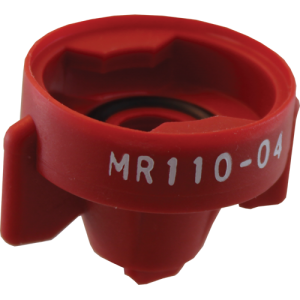
Combo-Jet® spray tips follow an ISO standard for their tip colors. The tip-caps also follow a standard labeling structure that describes everything about the tip in just a few numbers/letters.
For example: MR110-04
‘MR‘ specifies the series of the spray tips. This designates it a ‘mid range’ drift reduction spray tip. Each series of spray tip delivers a different spray quality (within the same flow rate size)
‘110‘ specifies the spray tip angle. 110° is a common spray tip angle for broadcast spraying.
‘-04‘ specifies the flow rate. The last numbers after the hyphen designate the flow rate at 40PSI with water, which is also the standard for the color of the tip-cap as well. -04 would translate to 0.4 US Gallons/Minute, which would be red (as per ISO standard).
Figuring out the Tip Wizard Results
SR110-05 Result Review
Quick Glance for Issues:
- Ideal pressure/droplet size occurs at almost max duty cycle.
- Less flexibility in having a “drift reduction mode” by dropping pressure.
SPEED RANGE (MPH): 3.78-15.1 MPH. Since our max speed is 15MPH, it does not give any room to go faster at all.
DUTY CYCLE (%): The duty cycle is our solenoid’s ON time. Each solenoid pulses at set intervals (ie. 1 pulse every 10th of a second), and the duty cycle is the amount of time that a solenoid is OPEN and spraying during that interval.
Not great. At 45PSI, it is effectively maxed out at our max speed. Ideally, duty cycle should be above 50% and below 100%. If a ‘sweet spot’ existed, it would be around the 70-80%. That way, if you start traveling a little faster or need to drop your pressure (for drift reduction at the same speed), you have that capability.
PRESSURE (PSI): Having our ‘ideal’ droplet size at 45PSI is fine; however, given our speed/duty cycle, we cannot drop our pressure without slowing down from our max.
VMD (microns): 320µ @ ~45PSI. GREAT. With PWM sprayers, it isn’t uncommon that we can match our ideal droplet size with a Combo-Jet® tip. With a PWM system, it is equally important that we account for further flexibility in the system, which usually means having the ability to start a ‘drift reduction mode’ by reducing pressure on the fly.With the SR110-05, the tip flow is small enough we do not have any room to really drop our pressure, limiting it’s flexibility.
% < 141µ (%): 11%. GOOD. As a general rule, we typically want to keep this number as LOW as possible, while maintaining the % <600µ figure as HIGH as possible.
Ultimately, droplets that are smaller than 141µ have a high propensity to drift, and are typically referred to as driftable fines. As we are applying a contact herbicide, we want to keep this as low as possible, while still managing to keep coverage consistent and suited to our mode of action. Given the example application, 11% is a reasonable figure for drift. For areas that have greater drift sensitivity (e.g. headlands, near neighboring fields, waterways, etc.), the operator would have to slow down to maintain a consistent rate at a lower pressure, reducing driftable fines.
% < 200 µ (%): 23%. GOOD. Droplets smaller than 200 microns have less propensity to drift, but in less than ideal conditions will become drift-prone. Consider the % < 200µ as driftable fines with a safety bubble. It provides a further glimpse of where the physical droplet spectrum curve would sit when it comes to smaller droplets.
% < 600µ (%): 94%. EXCELLENT. As a general rule, we typically want to keep this number as HIGH as possible, while maintaining the % <141µ figure as LOW as possible.
We want to minimize droplets larger than 600 microns as they typically provide less chemical efficacy than smaller, more meaningful droplets [e.g. smaller than 600 microns, but still larger than ~200 microns]. (Exceptions do apply based on different applications) As a frame of reference, anything over 80% would typically be satisfactory for a systemic herbicide targeting coarse or greater droplet size. For contact herbicides, insecticides, or fungicides, it is typically ideal to try maintain 90%+.
SR110-06 Result Review
Quick Glance for Issues:
- None.
SPEED (MPH): 5.09-20.4 MPH. Since our max speed is 15MPH, we have plenty of room to go faster.
At our turning speed (~9MPH), we are able to easily maintain duty cycles above 50% by dropping pressure to around 45PSI.
DUTY CYCLE (%): Excellent. At 60PSI, we are at a 74% duty cycle. We have the capability of dropping pressure down to ~35PSI to reduce drift, without slowing down. If choosing to slow down, there is still the ability to keep coverage maximized at 60PSI.
PRESSURE (PSI): Great.No issues with pressure being at 60PSI. Lots of room to reduce pressure to reduce drift.
VMD (microns): 330µ @ ~60PSI. Excellent. At 60PSI, we can ensure we get excellent exit velocity of spray to benefit both coverage as well as try minimize drift (by faster & Further traveling spray).
If we consider 40PSI our “Drift reduction mode”, we can reduce drift by ~4% (or ~36%) compared to spraying at 60PSI, without changing anything but our pressure.
% < 141µ (%): 11%. GOOD. As a general rule, we typically want to keep this number as LOW as possible, while maintaining the % <600µ figure as HIGH as possible.
Ultimately, the driftable fines are very similar to the SR110-05 at a lower pressure. As we described already, we do have significant flexibility to reduce this in areas/times that require further drift reduction.
% < 200 µ (%): 22%. GOOD. Very similar to the SR110-05; however, better ability to reduce driftable fines on the go, in inclement weather.
% < 600µ (%): 92%. EXCELLENT. Very similar to the SR110-05. No issues here.
If we consider 40PSI our “Drift reduction mode”, our 4% reduction in drift comes at the cost of ~5% of our flow made up of smaller droplets. This is a VERY good trade-off between drift reduction and coverage, for those times that demand it.
ER110-08 Result Review
Quick Glance for Issues:
- Starting pressure at ideal droplet size is too low for the spray tips’ operating pressure.
- Droplet size is too fine at reasonable spray pressures.
- Driftable fines is far greater than other alternatives for tips.
Due to significant issues with this tips ability to match our application, we will ignore it from our results. Find just a few highlights below:
SPEED (MPH): 4-16.7 MPH. Since our max speed is 15MPH, we have plenty of room to go faster.
At our turning speed (~9MPH), we are able to easily maintain duty cycles above 50%.
DUTY CYCLE (%): Fine. At 25 PSI, we are at a 90% duty cycle.
PRESSURE (PSI): Poor. Pressure is too low at 25PSI, as it is below the recommended operating pressure of the tip.
VMD (microns): 328µ @ ~25PSI. Poor. At 25PSI, we are too low of a pressure for effective spraying, and we cannot increase pressure without increasing driftable fines significantly. As the ER series is a conventional flat fan tip (not drift reduction), we should not consider using the ER110-08 for this application.
There is no capability for a “drift reduction mode”.
SR110-08 Result Review
Quick Glance for Issues:
- Cannot get too close to targeted droplet size, even at high pressures.
- Duty cycle at higher pressures (where we get finer coverage) is fairly low, and won’t allow for slowing down.
- Duty cycle will fall into ‘trouble zone’ during slower travel speeds or turns.
Due to significant issues with this tips ability to match our application, we will ignore it from our results. Find just a few highlights below:
SPEED (MPH): 6.7-27 MPH @65PSI. Since our max speed is 15MPH, the spray tip is too large to be reasonable for our travel speeds.
At our turning speed (~9MPH), we would not be able to maintain even a minimum of 50% duty cycle.
DUTY CYCLE (%): Not very good. At 65 PSI, we are at a 56% duty cycle.
PRESSURE (PSI): Okay. Pressure is pretty high at 65PSI, and droplet size is still very coarse.
VMD (microns): 370µ @ ~65PSI. Poor.
There is the ability to reduce drift considerably by lowering the pressure, but not much ability to maintain fine contact coverage needed for targeting grassy weeds.
Results Overview
Based on the review of the top 4 results in Tip Wizard, it is fairly clear the SR110-06 would suite our application the best. It provides the best travel speed range, while maintaining the spray quality we need, and provides sufficient drift reduction mode to cut down drift for areas that need it.
If conditions were more drift sensitive to the point where significant less drift is tolerated, the SR110-08 (at lower pressures) may be considered, or perhaps the MR110-06 (not reviewed in our results). If this is the case, adjust the targeted droplet size to be larger, and complete the search again.






